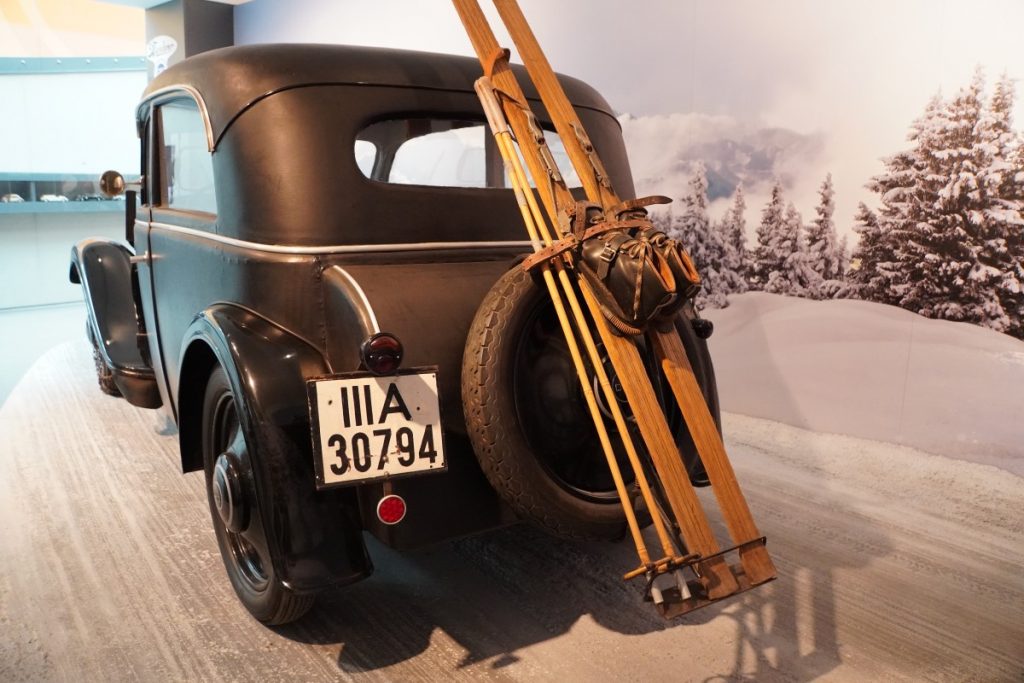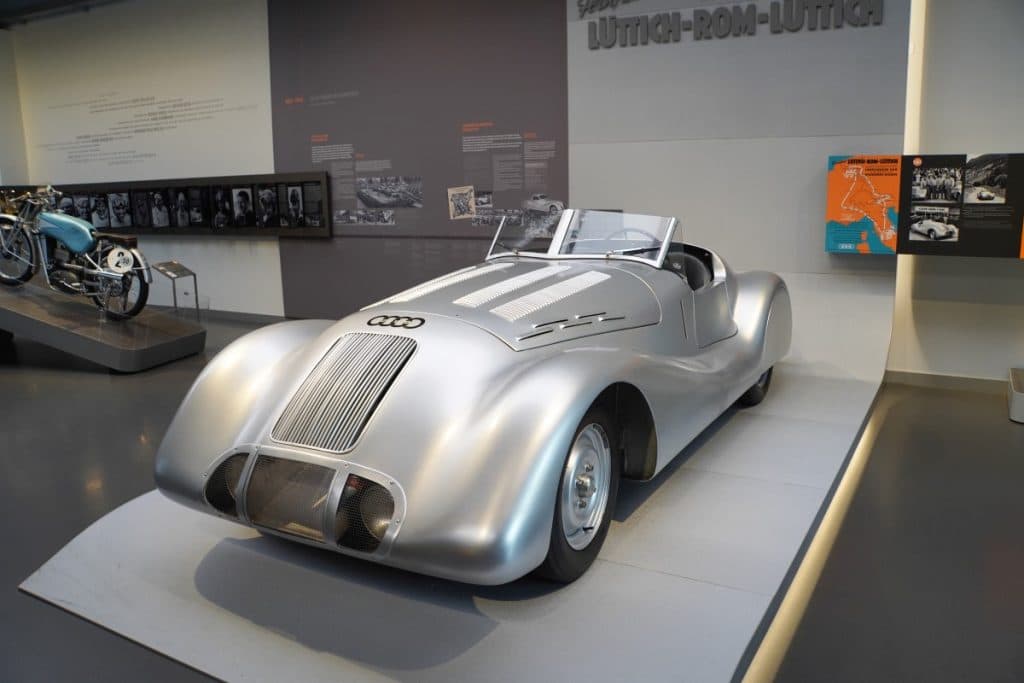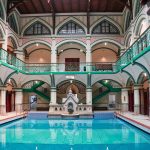For me, Zwickau was always linked to the topic of “cars” and so we were also drawn to the August Horch Museum. This automobile museum in Zwickau is located on the European Route of Industrial Culture and depicts the history of automobile manufacturing in the city.

Zwickau the car city
August Horch graduated from the technical college in Mittweida. In 1896, he began working for the Benz & Cie. company as head of the motor car construction department. In 1899, Horch set up his own business in Cologne and designed his first car, which he was able to test-drive for the first time in 1901.
In the beginning, money was tight and he sold too few cars. He moved his production to Reichenbach in the Vogtland region and from 1902 onwards manufactured mainly two-cylinder cars. Apparently a good move, because his cars became better known and Horch had to expand the production area.

He found a new production site in Zwickau and founded “August Horch & Cie. Motorenwagenwerke AG” on May 10, 1904. In the first two months, 13 cars were sold. Although the price was quite high, 82 cars were sold within the first two years. August Horch left the company in 1909 after a falling out with his business partners and founded “August Horch Automobliwerke GmbH” in Zwickau the same year.

Horch becomes Audi
His new company was located in the direct vicinity of the old one. This and certainly the rather similar name led to a legal dispute, which August Horch lost and now had to rename his company. From April 25, 1910, the company was now called “Audi Automobilwerke GmbH Zwickau”.
Small fact on the side: the Latin translation of Horch is Audi!

In 1915, the company was renamed “Audiwerke AG Zwickau”, and at the end of 1931 it was renamed again as “Auto Union AG”. The automobile division of Wanderer, DKW, Horch and Audi were now united under this name. The company offered a diverse range of vehicles from motorcycles to luxury cars. During the Second World War, they manufactured military vehicles and thus kept production alive.

After the war, the plant was almost completely dismantled as a reparation, and the company’s assets were expropriated. Auto Union AG was deleted from the commercial register. In 1958, the “VEB Sachsenring Automobilwerke Zwickau” was founded in Zwickau and now produced the Trabant.

After the political and economic turnaround, the VW Group merged with “VEB Sachsenring Automobilwerke Zwickau” in 1992 to form the IFA Kombinat PKW and now produced the VW Polo in Zwickau.
August Horch Museum
An automobile museum in Zwickau has existed since 1988, when an unused dining room in the basement was converted into an exhibition space. This can no longer be compared with today’s rooms. In 2004, a new exhibition was opened in a new building, incorporating the historic fabric of the old factory site. Today, there is about 6500 m² of space available, which is used by a permanent exhibition and temporary exhibitions.

The automobile museum in Zwickau is now one of the city’s tourist destinations and, in my opinion, not only for car enthusiasts. One should plan some time for the visit. We had a good 2 hours until the museum closed in the evening and would have liked to spend a little more time there.
Permanent exhibition in the automobile museum in Zwickau
The modern entrance building leads directly into the large exhibition area. Already the first view we had from the transition to a lower lying exhibition area showed me flashing and polished dreamlike beautiful cars. The view made me want to see more vehicles and I must say, the automobile museum in Zwickau really leaves nothing to be desired. About 160 large exhibits of cars, motorcycles and engines to numerous smaller exhibits and Mulitmediastationen – there is variety and anticipation of more.

In the automobile museum in Zwickau, you can learn about the history of the automobile industry on many panels and in small film clips. I found it very exciting.
What can you see in the automobile museum in Zwickau?
Cars from the period until 1945 of the historic brands Audi, DKW, Horch and Wanderer make the start. Cars from many different years are on display here. On the small boards next to the exhibits, car connoisseurs can learn everything important from the year of manufacture to engine performance. For me rather uninteresting, I was busy admiring the interior or looking at details such as suspension of the spare wheel.


I always like the vehicles that offer additional information from the past. So I discover a car that has an interesting transport system for the skis and a vehicle with a built-in water tap. I also find the police crew car with 3 rows of seats and the fire department car just great.


I liked the area where you walk through a small street scene (from the 30s). Here the cars are parked on the side of the road, you can take a look at the display in the windows of some stores or peek into a car repair shop. Almost like jumping back in time.


A door leads to August Horch’s office and a workshop area for production and development. Not only are there large machines here, but you also get a glimpse of some of the steps involved in car production. Some of the machines are supposed to be completely functional, such as a transmission drive system and a Horch engine test bench. I found the area on body construction exciting, which makes it very clear how much work went into this production step.

In another area of the exhibition, the theme of racing is addressed. Here you can see racing cars from the 1920s to the 1930s and watch a short film about racing. A race grandstand invites you to sit down and you can look at the race track, where some race cars are standing. Next to the track are service cars and other racing cars.

During the Second World War, military vehicles were manufactured in Zwickau. This area is also shown in the automobile museum in Zwickau. There are some vehicles from the war production on display.
Cars after 1945
The section of the exhibition at the Automobile Museum in Zwickau that deals with car manufacturing after 1945 is also very exciting. In the beginning, Zwickau produced pedal cars for children, then came tractors, trucks and passenger cars.

Of course, the topic Trabant must not be missing. I found the production plant very interesting. Here, thermoset plastic was produced from which parts of the Trabant were made. The shape of the body was pressed from short cotton fibers reinforced with phenolic resin. The advantages of this material were its stability, freedom from corrosion, low mass, ease of repair and easy/cheap availability. Disadvantages were, for example, the disposal, the long curing of the plastics and thus the blocking of the machines for new pressings.

Those who would like to can do a simulation drive in a Trabant. I tried it and didn’t even get the car rolling. I don’t think the gearshift and the intermediate throttle and I are going to be friends.

That you can also camp on the Trabi, I would not have thought. But if you can believe the advertising poster, the car was very stable!

The exhibition at the Automobile Museum in Zwickau concludes with a look at the current situation of VW Saxony and a glimpse into the future. In this area, for example, you can see a VW Golf Citystromer, a shot VW Phaeton special protection vehicle and a Bentley Bentayga body.
Want to see more?
Click here for a virtual tour virtual tour of the automobile museum in Zwickau.
We enjoyed the visit very much and with one or the other car I would have liked to drive through the area.

Address:
August Horch Museum Zwickau gGmbH
Audistraße 7
08058 Zwickau
Opening hours:
Tuesday – Sunday: 9:30 – 17 h
Special opening hours:
New Year’s Day 13 – 17 h
Whit Monday: 9.30-17 h
closed:
24.12.; 25.12.; 31.12.
Admission fees:
Adults: 11,-€
Discounts are offered.

Disclosure: The visit to the August Horch Museum Zwickau took place as part of a research trip. This article was written independently of the visit.










Leave a Reply